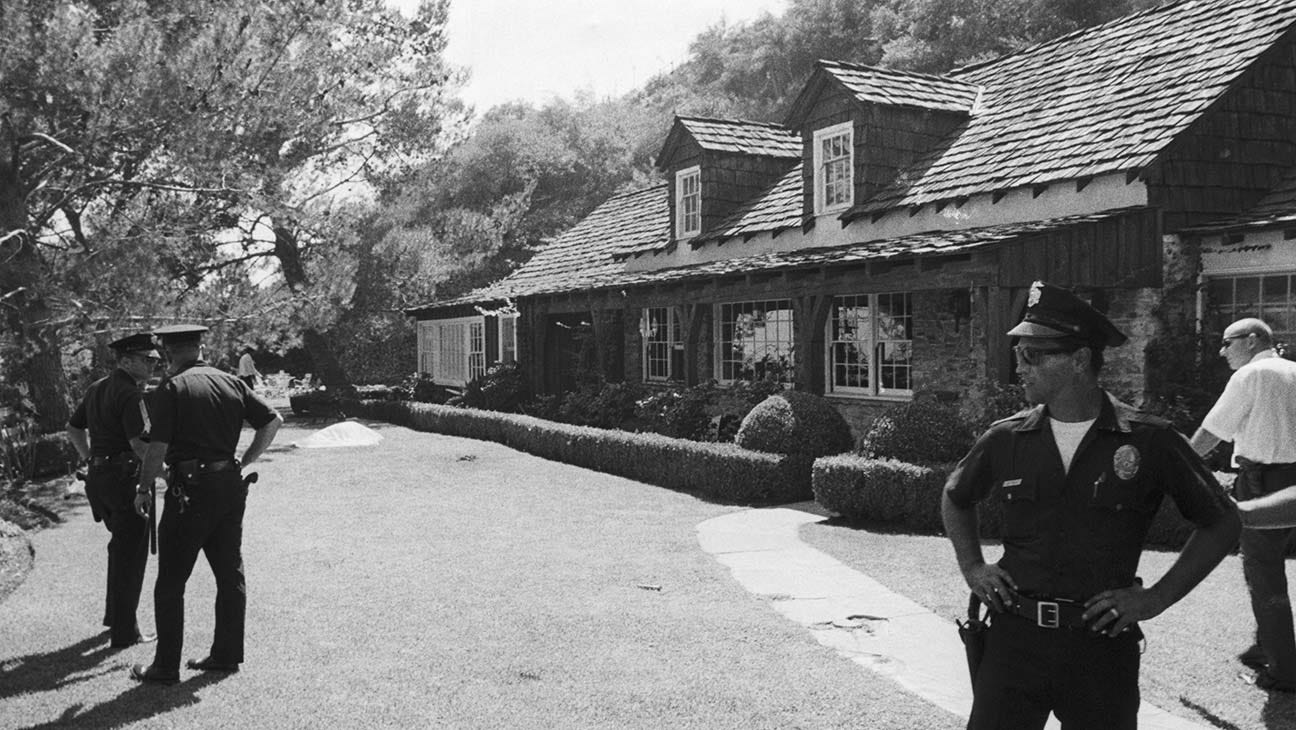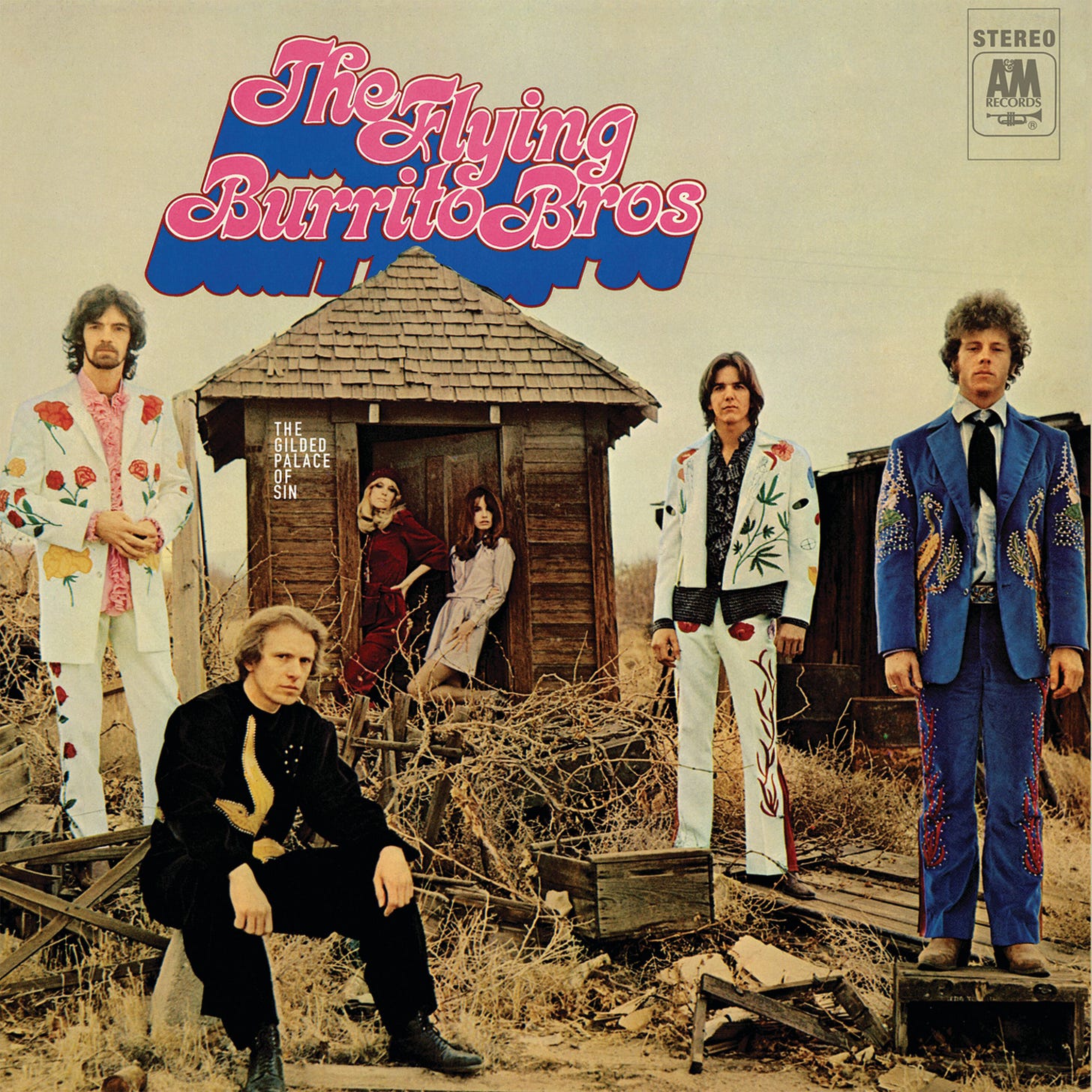The Flying Burrito Brothers - The Gilded Palace of Sin (1969)
Off Mulholland Drive in Hollywood’s hills lies 2786 La Castana Drive, or “Burrito Manor” as it was known to Gram Parsons in 1968.
Parsons had recently quit the Byrds; the band he’d joined in 1967 and then turned on to country music. Now, he hunkered down in the Laurel Canyon-style house to plot his future with fellow ex-bandmate Chris Hillman.
The pair spun records, sharing tastes as they passed joints — country, R&B, psychedelic rock; Merle Haggard, Aretha Franklin, the Rolling Stones — and quickly wrote their own songs influenced by this heady eclectic mix.
From Burrito Manor spawned country-rock supergroup, the Flying Burrito Brothers: Gram Parsons, Chris Hillman, Michael Clarke, previously of the Byrds, with Parson’s old International Submarine Band-mate Chris Etheridge, and session musician Sneaky Pete Kleinow.
The band’s debut album, a mix of covers and originals called The Gilded Palace of Sin, left record stores in February 1969 to critical acclaim. Stanley Booth wrote in his Rolling Stone review:
Together, the mercurial Gram Parsons and the level-headed Chris Hillman have concocted a crazily coherent statement of irony-fuelled hillbilly anthems, inventive covers and achingly beautiful two-part harmonies…
But something else was brewing in the Hollywood hills as 1969 unfolded, eventually erupting on the other side of Laurel Canyon at 10050 Cielo Drive on 9 August — as members of Charles Manson’s cult murdered actress Sharon Tate and four companions for no clear reason.
In “The White Album”, Joan Didion’s 1979 essay on the aftermath of the Manson murders, the writer chooses the Burrito Brothers and The Gilded Palace of Sin, along with the laid-back country rock of Bob Dylan’s Nashville Skyline, to introduce the brutal killings to her readers:
We put “Lay Lady Lay” on the record player… [And] went down to Melrose Avenue to see the Flying Burritos…
I imagined that my own life was simple and sweet, and sometimes it was , but there were odd things going around town. There were rumors. There were stories. Everything was unmentionable but nothing was unimaginable.
This mystical flirtation with the idea of “sin” — this sense that it was possible to go “too far,” and that many people were doing it — was very much with us in Los Angeles in 1968 and 1969. A demented and seductive vortical tension was building in the community. The jitters were setting in.
I recall a time when the dogs barked every night and the moon was always full. On August 9, 1969, I was sitting in the shallow end of my sister’s swimming pool in Beverly Hills when she received a call from a friend who had just heard about the murders at Sharon Tate Polanski’s house on Cielo Drive.
The juxtaposition between the Burrito’s easy-going, free-loving, pot-tinged country rock and Manson’s blood-soaked apocalyptic zealotry is deliberate. One begat the other. Parsons and his Laurel Canyon rockstar coterie, with their Devil-may-care attitude to drugs, sex and work — Didion lightly suggests — had tempted Lucifer into retribution.
Neil Young distils this unease into two lines of “Revolution Blues”: “They say that Laurel Canyon is full of famous stars / But I hate them worse than lepers and I’ll kill them in their cars.”
It’s a subject that Parsons and Hillman touch on in The Palace of Gilded Sin, not least with the title of the album, presciently recorded almost a year before the murders.
The record’s second track, “Sin City”, could have easily been written about the heavy post-Manson atmosphere in LA evoked by Didion in “The White Album”.
The song begins:
This old town is filled with sin
It’ll swallow you in
If you’ve got some money to burn
And continues in the chorus:
It seems like this whole town’s insane
On the thirty-first floor a gold plated door
Won't keep out the Lord’s burning rain
Of course, it’s not about Manson. It’s about the Burrito’s manager, Larry Spector, who literally lived behind a gold-plated on the 31st floor. According to Hillman, quoted in the LA Times, “Spector was a thief, it was as simple as that. And his condo, he lived on the 31st floor behind this awful, garish gold door.”
“Sin City” was intended, Hillman continues, as a warning to young people who came to LA “all bright-eyed and talented and idealistic, and the whole thing just swallowed [them] up.”
Similarly, the third verse again echoes Manson who, to some degree, “tried to clean up this town” and whose ideas certainly “made some people mad”:
A friend came around
Tried to clean up this town
His ideas made some people mad
Naturally the verse isn’t about Manson, but another murder in the year it was written, 1968. “We were talking about Robert F. Kennedy”, says Hillman. The presidential candidate was shot in LA’s Ambassador Hotel on 5 June.
Just as the Burritos had soundtracked Kennedy’s assassination in “Sin City”, and the Tate-LaBianca murders for Didion, they also provided the backdrop for the sixties’ final epoch-shattering murder.
While touring England with the Byrds in the summer of 1968, Parsons became firm friends with Keith Richards. Indeed the Burritos spent October 1969 hanging out with the Stones in Stephen Stills’ Laurel Canyon home, as the fallout from Tate-LaBianca murders unfurled around them.
So when the Stones needed opening acts for their ill-fated Altamont festival on 6 December 1969, the Burritos were an obvious choice.
The night ended with the killing of 18-year-old Meredith Hunter by members of the Hell’s Angels.
What had started as a celebration of American music at Burrito Manor had turned sinister — and with it Parson’s own drug taking, as he slid with Richards into heroin addiction.
recalls photographer Barry Feinstein of the album’s cover-shoot in the Mojave desert.
Gram Parsons had contracted legendary Nashville tailor Nudie Cohn to create rhinestone cowboy suits for each bandmember. Parsons’ countrified get-up glittered with illicit leaves, pills and poppies, instead of the usual guitars and horses.
As they wandered through the desert, the overdressed group stumbled upon a derelict hut — a fitting visual gag for the ‘gilded palace’ — and posed for photos with two models, Suzanne and Bridget, sent along by the label for added glamour.
The hut stands only a couple of miles away from the Joshua Tree Inn, a Spanish colonial-style motel off Highway 62. Later, in September 1973, Gram Parsons died in this motel, overdosing on morphine in room one.
It was an unlikely resting place for Parsons, who was born Cecil Ingram Connor III in 1946, as heir to a Florida orange-growing dynasty responsible for a third of the state’s crop.
But his upbringing was not exclusively privileged: at age 12, Parsons lost his father to suicide, and, at 18, his mother succumbed to fatal alcoholism.
In 1966, Parsons dropped out of Harvard to pursue a life in music, ultimately following his parents to the “Dark End of the Street”, as is the title of Gilded Palace’s best track.
Originally recorded by James Carr in 1967, “Dark End of the Street” is a love song about a couple who must hide their affair in the shadows:
At the dark end of the street
That’s where we always meet
Hiding in shadows where we don’t belong
Living in darkness to hide our wrong
Hillman and Parsons’ harmonies soar as the song builds, fighting toe-to-toe with Carr’s flawless original.
Whereas the subtext to Carr’s version is civil rights-era racism (you can read the song as being about a then-still-taboo interracial affair — indeed Danielle L. McGuire uses the song’s title for a book on the experience of Black women during segregation), when Parsons sings it’s impossible not to think of his life and estrangement from his wealthy Southern dynasty.
Parsons chose not to spend his years at Magnolia Mansion — the white-columned Antebellum house built by his Orange tycoon grandfather — but instead the ‘dark end’ of boozy motels and LA’s bohemian hills.
But “Dark End of the Street” ends with an ominous premonition:
They’re gonna find us
They’re gonna find us
They’re gonna find us, Lord, someday
For Parsons, it didn’t take long. In five years, he’d travelled from Burrito Manor to the Joshua Tree Inn — from artsy Hollywood idyll to a cheap motel — and to an untimely death at 26.
To prevent Parsons’ family burying their son in the estate he’d spent his life trying to escape, his road manager, Phil Kaufman, stole the body from and drove to Joshua Tree.
He doused it in gasoline and cremated Parsons not far from where he stands on the cover of The Gilded Palace of Sin, forever glistening in rhinestones.












:max_bytes(150000):strip_icc():focal(749x0:751x2)/john-lennon-rollout-12052326-74ceb860465746e496154126d5eecf02.jpg)
:max_bytes(150000):strip_icc():focal(999x0:1001x2)/john-lennon-parents-2-95d5f565df7a41da9936a868c42ee52c.jpg)
:max_bytes(150000):strip_icc():focal(749x0:751x2)/john-lennon-george-harrison-1-042525-c404ef5bfb9b4e1bb3c2c37100ac8a13.jpg)